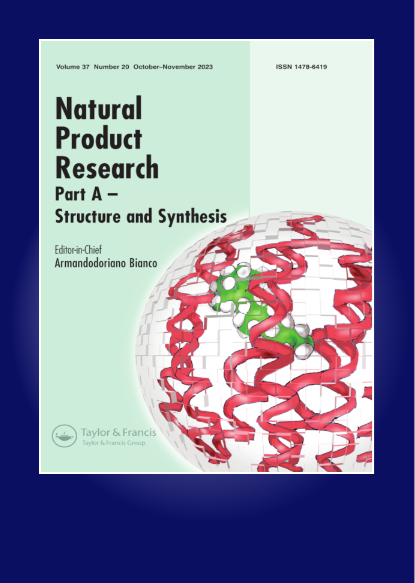In silico analysis, isolation, and cytotoxicity evaluation of the coumestans from Cullen corylifolium (L.) Medik
IF 1.9
3区 化学
Q3 CHEMISTRY, APPLIED
引用次数: 0
Abstract
Cullen corylifolium is well known for diverse phytoconstituents that possess multifaceted pharmacology, and one such less explored class is coumestans, which have not been well explored for their anticancer activities. One of the popular cancer targets is the Epidermal Growth Factor Receptor, a tyrosine kinase involved in various cancers, especially breast and lung cancer hence, a crucial cancer target. This work is focussed on molecular docking and molecular simulation studies on coumestans against EGFR. The rigorous docking studies resulted in two coumestans (1 and 5) with binding energy less than Gefitinib and Erlotinib. Compounds 1 and 5 were subjected to molecular simulation, binding free energy calculation, per-residue energy decomposition, and in silico ADMET prediction. The best hit, compound 1 was evaluated for its cytotoxicity against MDA-MB-231 and A549 cells via in vitro assay. The ligand-protein complex exhibited good stability, binding free energies, better in silico pharmacokinetics, low toxicity, and good cytotoxicity.
Cullen corylifolium (L.)中古美斯坦类化合物的硅分析、分离及细胞毒性评价Medik。
鸢尾草以其具有多方面药理作用的多种植物成分而闻名,其中一类较少被探索的是coumestans,其抗癌活性尚未被很好地探索。其中一个流行的癌症靶点是表皮生长因子受体,一种酪氨酸激酶参与各种癌症,特别是乳腺癌和肺癌,因此是一个重要的癌症靶点。本文主要开展抗EGFR药物的分子对接和分子模拟研究。严格的对接研究结果显示,两种库米斯坦(1和5)的结合能低于吉非替尼和厄洛替尼。对化合物1和5进行了分子模拟、结合自由能计算、每残基能量分解和硅ADMET预测。体外实验评价了最佳化合物1对MDA-MB-231和A549细胞的细胞毒性。该配体-蛋白复合物具有良好的稳定性、结合自由能、较好的硅药代动力学、低毒性和良好的细胞毒性。
本文章由计算机程序翻译,如有差异,请以英文原文为准。
求助全文
约1分钟内获得全文
求助全文
来源期刊

Natural Product Research
化学-医药化学
CiteScore
5.10
自引率
9.10%
发文量
605
审稿时长
2.1 months
期刊介绍:
The aim of Natural Product Research is to publish important contributions in the field of natural product chemistry. The journal covers all aspects of research in the chemistry and biochemistry of naturally occurring compounds.
The communications include coverage of work on natural substances of land and sea and of plants, microbes and animals. Discussions of structure elucidation, synthesis and experimental biosynthesis of natural products as well as developments of methods in these areas are welcomed in the journal. Finally, research papers in fields on the chemistry-biology boundary, eg. fermentation chemistry, plant tissue culture investigations etc., are accepted into the journal.
Natural Product Research issues will be subtitled either ""Part A - Synthesis and Structure"" or ""Part B - Bioactive Natural Products"". for details on this , see the forthcoming articles section.
All manuscript submissions are subject to initial appraisal by the Editor, and, if found suitable for further consideration, to peer review by independent, anonymous expert referees. All peer review is single blind and submission is online via ScholarOne Manuscripts.
 求助内容:
求助内容: 应助结果提醒方式:
应助结果提醒方式:


